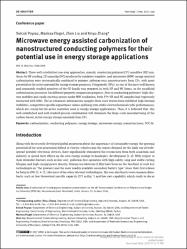| dc.contributor.author | Poyraz, Selçuk | |
| dc.contributor.author | Flogel, Marissa | |
| dc.contributor.author | Liu, Zhen | |
| dc.contributor.author | Zhang, Xinyu | |
| dc.date.accessioned | 2022-05-11T14:28:14Z | |
| dc.date.available | 2022-05-11T14:28:14Z | |
| dc.date.issued | 2017 | |
| dc.identifier.issn | 0033-4545 | |
| dc.identifier.issn | 1365-3075 | |
| dc.identifier.uri | https://doi.org/10.1515/pac-2016-1109 | |
| dc.identifier.uri | https://hdl.handle.net/20.500.11776/6717 | |
| dc.description | 16th International Conference on Polymers and Organics Chemistry (POC) -- JUN 13-16, 2016 -- Hersonissos, GREECE | en_US |
| dc.description.abstract | Three well-established one-step approaches, namely, conducting polymer (CP) nanofiber (NF) synthesis by NF seeding, CP nanoclip (NC) synthesis by oxidative template, and microwave (MW) energy-assisted carbonization were systematically combined to prepare carbonaceous nanostructures from CPs, with great potential as the active material for energy storage purposes. Polypyrrole (PPy), as one of the most well-known and commonly studied members of the CP family was prepared in both NF and NC forms, as the sacrificial carbonization precursor, for different property comparison purposes. Due to conducting polymers' high electron mobility and easily exciting nature under MW irradiation, both PPy NF and NC samples had vigorously interacted with MWs. The as-obtained carbonaceous samples from such interactions exhibited high thermal stabilities, competitive specific capacitance values and long-term stable electrochemical cyclic performances, which are crucial for the active materials used in energy storage applications. Thus, it is believed that, this well-established and well-studied process combination will dominate the large-scale manufacturing of the carbon-based, active energy storage materials from CPs. | en_US |
| dc.description.sponsorship | National Science FoundationNational Science Foundation (NSF) [EEC-1063107]; Namik Kemal University scientific research awardNamik Kemal University [NKUBAP.00.17.AR.15.04] | en_US |
| dc.description.sponsorship | The authors gratefully acknowledge the financial support from National Science Foundation Award EEC-1063107 and Namik Kemal University scientific research award NKUBAP.00.17.AR.15.04. | en_US |
| dc.language.iso | eng | en_US |
| dc.publisher | Walter De Gruyter Gmbh | en_US |
| dc.identifier.doi | 10.1515/pac-2016-1109 | |
| dc.rights | info:eu-repo/semantics/openAccess | en_US |
| dc.subject | carbonization | en_US |
| dc.subject | conducting polymers | en_US |
| dc.subject | energy storage | en_US |
| dc.subject | microwave energy | en_US |
| dc.subject | nanostructures | en_US |
| dc.subject | POC-16 | en_US |
| dc.subject | Lithium-Ion Batteries | en_US |
| dc.subject | Carbon Nanofiber Webs | en_US |
| dc.subject | Anode Materials | en_US |
| dc.subject | Seeding Approach | en_US |
| dc.subject | Porous Carbon | en_US |
| dc.subject | Polypyrrole | en_US |
| dc.subject | Nanotubes | en_US |
| dc.subject | Degradation | en_US |
| dc.subject | Template | en_US |
| dc.subject | Catalyst | en_US |
| dc.title | Microwave energy assisted carbonization of nanostructured conducting polymers for their potential use in energy storage applications | en_US |
| dc.type | proceedingPaper | en_US |
| dc.relation.ispartof | Pure and Applied Chemistry | en_US |
| dc.department | Fakülteler, Çorlu Mühendislik Fakültesi, Tekstil Mühendisliği Bölümü | en_US |
| dc.authorid | 0000-0003-3830-4096 | |
| dc.authorid | 0000-0003-4260-4948 | |
| dc.authorid | 0000-0003-4260-4948 | |
| dc.identifier.volume | 89 | en_US |
| dc.identifier.issue | 1 | en_US |
| dc.identifier.startpage | 173 | en_US |
| dc.identifier.endpage | 182 | en_US |
| dc.institutionauthor | Poyraz, Selçuk | |
| dc.relation.publicationcategory | Konferans Öğesi - Uluslararası - Kurum Öğretim Elemanı | en_US |
| dc.authorscopusid | 36554590700 | |
| dc.authorscopusid | 57193715698 | |
| dc.authorscopusid | 56200936400 | |
| dc.authorscopusid | 36505490200 | |
| dc.authorwosid | Zhang, Xinyu/B-3582-2008 | |
| dc.authorwosid | Zhang, Xinyu/AAP-9654-2021 | |
| dc.authorwosid | Poyraz, Selcuk/AAF-5497-2019 | |
| dc.authorwosid | Poyraz, Selcuk/O-5161-2016 | |
| dc.identifier.wos | WOS:000396505000016 | en_US |
| dc.identifier.scopus | 2-s2.0-85016035468 | en_US |



















